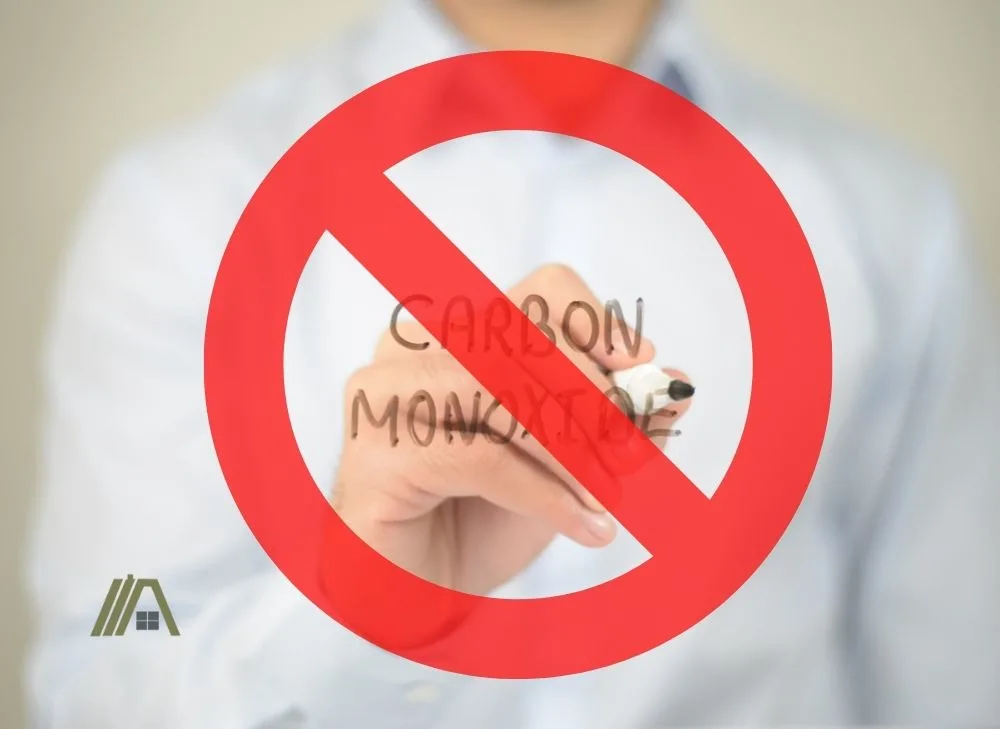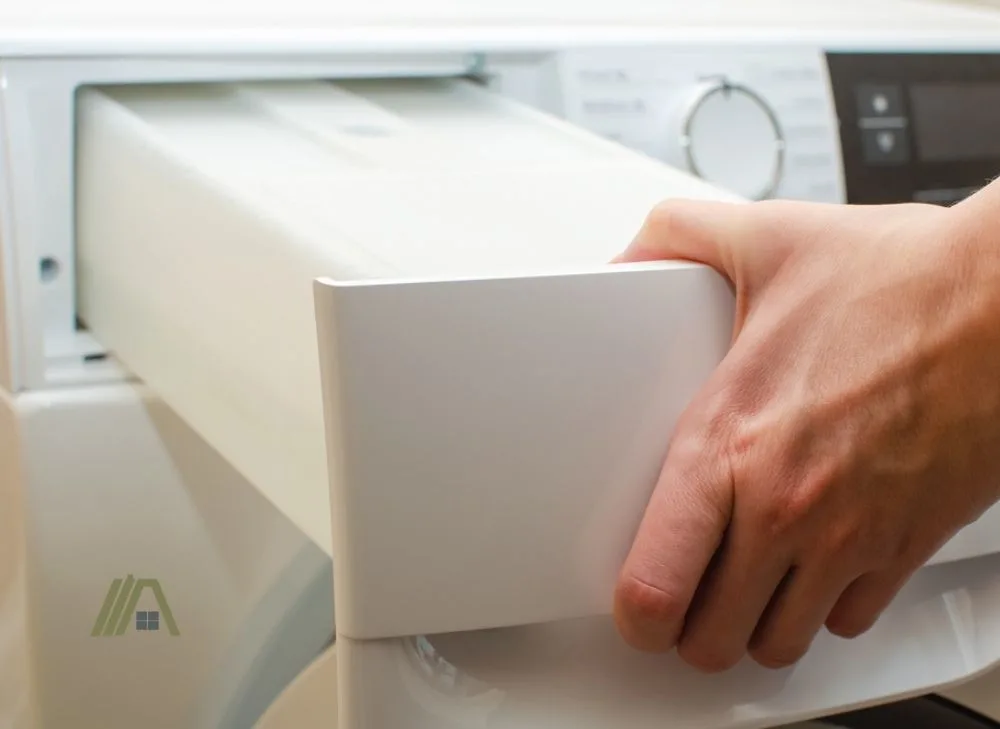It is quite easy to read that gas dryers produce carbon monoxide and then decide that gas dryer exhaust is dangerous but electric dryer exhaust is safe. This is not the case at all, though, and electric dryer exhaust is certainly not meant to be vented anywhere but outside.
Dangerous components of electric dryer exhaust may not include carbon monoxide but they do include hot, moist air, lint, and dangerous chemicals. These can lead to a variety of health, home, and financial problems if this exhaust is to be vented inside.

It is not safe to vent an electric dryer inside. Deposited lint can cause negative health effects and is flammable. Warm and moist air lowers the indoor air quality and poses a threat to health and the structural integrity of the home. Indoor venting is also against building codes.
Electric Dryers Don’t Produce CO
A large risk of venting dryer exhaust, specifically from gas dryers, inside is that carbon monoxide (CO) is produced during the combustion process. This means that exhaust from a gas dryer vented inside would lead to accumulation of CO inside the home.

CO cannot be detected through sight, smell, or taste since this gas is colorless, odorless, and tasteless.
Because of this, it is effectively impossible to know if there are dangerous amounts of CO in your home unless you have a CO detector or, terribly, you and your loved ones suffer adverse health effects or fatalities.
This gas is also dangerous because CO-poisoning symptoms are similar to a cold or the flu. This makes it even harder to detect.
When enough of it is breathed in, CO can prevent your blood cells from carrying oxygen. CO can fundamentally damage your organs and kill you if you are exposed for long enough.
Thankfully, electric dryers don’t produce CO because they fully utilize electricity and not gas to create heat.
However, this does not mean that venting an electric dryer inside your home is safe or desirable. Even venting under an enclosed deck is potentially harmful.
Hot, Moist Air Is a by-Product of All Dryers
While CO is not a risk in the exhaust of an electric dryer, hot, moist air surely is.
The most basic and noticeable part of hot, humid air being vented into your home is that it is uncomfortable. Moist air tends to feel like it is clinging to you and can make warm temperatures feel even warmer.
This discomfort can be countered by using a dehumidifier and using fans or air conditioning but it could easily be avoided by venting your dryer exhaust outside. This is certainly preferable considering that running a dehumidifier, fan, or air-conditioning will cost you more money.
Moisture is not only uncomfortable but can lead to health problems. Excess moisture in your home can lead to mold and mildew, which can also have adverse health effects. Moisture can negatively affect water damage-prone aspects of your home.
Although these situations are quite a bit less dangerous than CO-poisoning, they can still impact health and cause damage to your home, as you will see in the following sections.
Risks Linked With Venting Electric Dryers Indoors
Mold
Unfortunately, with damp conditions comes a higher likelihood that mold will grow in your home.

Not only is mold rather ugly, especially when it grows on walls, but mold also is a common allergen.
Mold in your home will lower the air quality with its undesirable smell and spores, cause allergic reactions in those that are allergic, and cause asthma attacks in those with asthma.
There are also toxic types of mold that can grow in your home and which can affect you even if you are not predisposed.
Structural Damage
As humidity rises in your home, materials sensitive to water, such as wood and paper, can suffer the effects.
Wood flooring, wooden beams, wallpaper, and insulation would accumulate condensation and after a while, they would begin to rot, deteriorate, and warp, particularly if these items are of poor quality or have not been well maintained.
Deterioration is rather expensive, especially for wood flooring, which can be quite expensive to repair or reinstall.
As insulation deteriorates the home would become even less air-tight than before. Air would escape the home and also get into the home easier. This could easily raise your energy bills by making your HVAC system work harder. Insulation is a vital part of maintaining an energy-efficient HVAC system.
Rotting could also be dangerous if it is happening to important structures. If wooden structural beams were rotting, the structure would become unstable and could cause a collapse and possible injury.
Lint Deposition
Another component of dryer exhaust is lint.

Venting your electric dryer inside would lead to lint deposition and accumulation in your home. With loose lint traveling through the air, it is likely to behave like dust and settle on your furniture and floors.
This would require some cleaning to fix, and because it is so static you’re like never get it out of the bristles of your broom or the fringe of your vacuum cleaner (you know what I’m talking about!).
Similar to dust, lint in the air could cause allergy symptoms in those who breathe in this air.
Lint is certainly not meant to be inhaled but an even more dangerous aspect of lint is its flammability. If lint was to form a large enough pile, a spark generated near this area could ignite and cause a fire.
This is especially dangerous in areas like the kitchen where open flames are common when using the stove. If lint was to accumulate near the stove, this could cause a fire.
Miscellaneous Chemicals in Dryer Exhaust
Although electric dryer exhaust does not contain CO, it can contain dangerous chemicals from products used in the dryer.
For example, dryer sheets and fabric softeners can contain benzyl acetate. This chemical ingredient can cause respiratory problems.
This chemical and other components of washer and dryer-related materials can be carried in electric dryer exhaust and can cause nausea, dizziness, headaches, and more.
Hard to Breathe Hot, Humid Air
If you feel like breathing gets harder on hot, humid summer days, then you are not alone. Just like humidity can make the air seem hotter than it is, it can also make breathing difficult.

Because humid air is more stagnant than dryer air, dust, pollen, smoke, mold, and other pollutants are more likely to get trapped in this air.
All of these pollutants make it more difficult to breathe and can trigger asthma attacks.
With the air in your home being warmer and more humid, you may find that it is more difficult to breathe and you are likely feel the need to invest in additional appliances such as air purifiers.
Also Against Code
The points above are reason enough to avoid venting electric dryer exhaust into your home. On top of that, though, it is against the International Residential Code (IRC) to vent any type of dryer exhaust into your home.
Section M1502.2 of the IRC states:
“Dryer exhaust systems must be independent of all other systems and shall convey the moisture to the outdoors.”
Section M1502.3 of IRC reiterates this, stating:
“Exhaust ducts shall terminate on the outside of the building.”
This section also says that the exhaust duct must terminate at least 3 feet away from openings of buildings, meaning that even a little bit of the air blowing back into the house must be avoided.
The IRC recognizes the danger of both gas and electric dryer exhaust and includes these sections to try to prevent homeowners from venting either exhaust type into their homes.
Additional Drawbacks
Affects House Sales
Various aspects of venting your electric dryer inside would make a home tour unsuccessful.
- The air of the home would most likely be noticeably stuffy, hot, and humid.
- The sight and smell of mold would also be likely to turn away potential buyers.
- Warping of floors, peeling of wallpaper, and other degradation of wooden home items would be yet another factor that could turn away potential buyers.
- The venting of dryer exhaust would also be fairly noticeable to those who enter since the ventilation system would look significantly different from their own. If they know that the IRC does not allow this or if they know that this is an unwise decision, they may not want to consider the home since the ventilation would have to be fixed to adhere to the code.
Fines
In the event of a home inspection, the inspector will find the ventilation of your dryer exhaust into your home to be a violation of the IRC. This would lead to a fine and they will most likely require you to bring your home up to code.
Will Most Likely Have to Vent Anyway
If you vented your dryer exhaust into your home to avoid the lengthy process of venting your dryer exhaust outside, this is very likely to cause you more trouble than what it would have taken to vent your dryer exhaust outside.
You are bound to be fined and then required to bring your home up to code. If you do not do this, more fines or legal action can be issued.
Compromised Insurance
As a result of non-compliance with building codes, your home is more likely to be assigned as higher risk and this will affect your insurance premium negatively.
Moreover, if the venting situation was not disclosed and it caused some kind of structural damage or water damage to the house, then when it came time to claim, the insurance company could deny the claim.
Condenser Boxes/Indoor Vent Kits Don’t Work
A condenser box is a place of collection for water from your dryer exhaust.

This is meant to be a substitute for venting your dryer exhaust since the box is supposed to contain the exhaust indoors with a hose.
Indoor dryer vent kids are basically just lint traps. The hot, moist air released by the dryer freely moves into the room.
These alternatives do not work for a variety of reasons and both condenser boxes and indoor dryer kits violate the IRC for the same reasons that venting dryer exhaust inside does.
Besides their nonadherence to the IRC, condenser boxes also often have hose attachments that lead to leaks and are not great at holding all of the exhaust in the box. This leaking can cause similar problems to those laid out above. As mentioned earlier, indoor dryer vent kits don’t even try to contain the exhaust.
Can’t Vent? Go Ventless
If the concern with your dryer exhaust is that the placement of your dryer is not conducive to venting outside, it is not a good idea to vent inside or use a condenser box.
Instead, you should use a ventless dryer, which has manifold advantages.
Common ventless dryer types include heat pump and condenser dryers. These both take in air from the surrounding area, heat the inside of the dryer, causing the water in the fabric to become a vapor. Then, this vapor is cooled so that the water condenses and the clothing is dry.
The main difference between a heat pump and a condenser dryer is that a heat pump dryer uses old water from previous loads to generate hot, humid air to vaporize the water in the fabric. A condenser dryer does not use this process and instead collects this water to be emptied later.
Besides not having to vent your dryer, other advantages of having a ventless dryer include that they are energy-efficient, take up much less space, and require less maintenance.
Disadvantages include their price, limited load capacity, and longer drying times.
These factors must be considered but if your primary concern is venting, a ventless dryer may be for you.
Sources
https://www.hunker.com/12468308/health-effects-of-a-dryer-vent-discharging-inside-of-a-house
